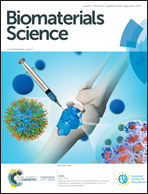A PEGylated alternating copolymer with oxidation-sensitive phenylboronic ester pendants for anticancer drug delivery†
Abstract
To target a response to a high oxidative stress environment of inflammatory or tumor sites, various reactive oxygen species (ROS) sensitive polymers have been developed as drug delivery systems. In this study, a novel oxidation sensitive copolymer, phenylboronic acid pinacol ester-functionalized methoxyl poly(ethylene glycol)-block-poly(phthalic anhydride-alter-glycidyl propargyl ether) (mPEG-b-P(PA-alt-GPBAe)), was designed and synthesized by ring-opening alternating copolymerization (ROAP) and click reaction. The copolymers could self-assemble into micelles in aqueous solution with an average size of 20.3 ± 9.3 nm, and are able to load hydrophobic anticancer drug (doxorubicin, DOX) with a high encapsulation efficiency of 75.2%. Interestingly, the encapsulated drug showed accelerated release in the trigger of H2O2, or at low pH values. The copolymers have low cytotoxicity indicated by the 3-(4,5-dimethyl-thiazol-2-yl)-2,5-diphenyl tetrazolium bromide (MTT) assay towards 4T1 cells, which showed cell viabilities of more than 80% with treatment of our copolymers at concentrations up to 0.5 mg mL−1. The effective uptake of the drug-loaded micelles by 4T1 cells was investigated by confocal laser scanning microscopy (CLSM) and flow cytometry (FCM) analysis. Finally, compared with free DOX, the DOX-loaded nanoparticles exhibited a better antitumor effect and had lower systemic toxicity in 4T1 tumor-bearing mice. Therefore, this new kind of copolymer acting as a stimuli-responsive nanocarrier should represent a promising therapeutic platform for cancer therapy.



 Please wait while we load your content...
Please wait while we load your content...